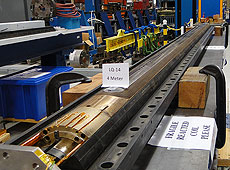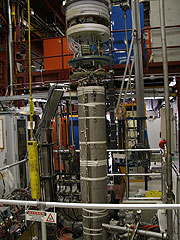Three cheers for niobium tin
 |
This 4-meter-long quadrupole coil recently achieved the ultimate magnetic-field strength expected for niobium tin coils of this design. |
This month, scientists are celebrating the centennial of the discovery of superconductivity, a fundamental phenomenon that has made possible the newest achievement in Fermilab’s Technical Division.
Shortly before the anniversary, researchers with the laboratory’s High Field Magnet (HFM) program successfully demonstrated optimal performance of a 4-meter-long niobium tin quadrupole coil in the temperature range from 1.9 to 4.6 Kelvin.
The achievement is an important milestone toward developing niobium tin magnets as a viable technology for accelerators.
“We’ve finally achieved the ultimate niobium tin coil performance,” said Alexander Zlobin, head of the HFM program.
Magnet coils in accelerators such as the Tevatron and the Large Hadron Collider are made of niobium titanium. Scientists would like to ramp up accelerators’ magnetic-field strength by instead using niobium tin, a brittle but more highly superconducting material.
Since 2005 Fermilab scientists have conducted niobium tin studies in support of the LHC Accelerator Research Program (LARP), a U.S. collaboration that contributes R&D for LHC upgrades. One of LARP’s goals is to demonstrate by 2014 that the technology is a good option for the LHC.
To that end, the HFM group has been experimenting with new processes for making quadrupole coils.
In recent months, the HFM group developed new coil insulation. They also redesigned the conductor previously used in LARP’s long quadrupole magnet by implementing twice as many smaller-diameter niobium tin filaments.
After many tests using shorter coils and a so-called mirror structure, they tested the new niobium tin conductor and insulation in a 4-meter-long LARP quadrupole coil.
The group achieved a stable field of 12.3 Tesla at 4.5 Kelvin. At 1.9 Kelvin, they achieved a stable 13.3 Tesla.
“The small filaments worked great,” said Giorgio Ambrosio, leader of the LARP long-quadrupole program. “Once you make this technology available for accelerator magnets, it can be used for the LHC, a muon collider, or a neutrino factory. It can be used anywhere.”
--Leah Hesla
 |
|
The Fermilab-developed and -assembled mirror structure used in tests of 4-meter-long niobium tin quadrupole coil. In a quadrupole mirror structure, three of the four poles are iron blocks rather than coils. The design produces conditions close to the real magnet but drastically reduces cost and processing time.
|
|